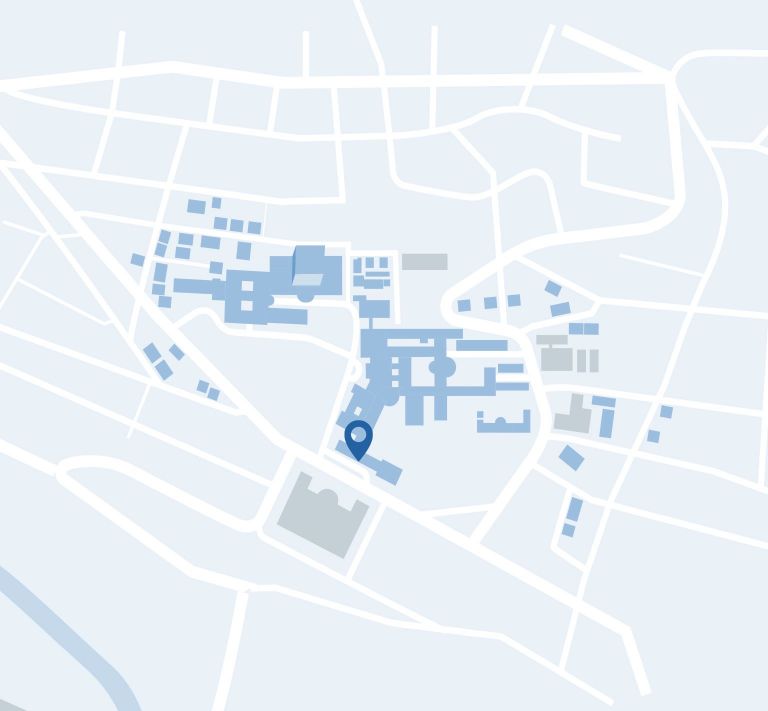Center for Interdisciplinary Craniofacial Surgery
The diagnosis of a cleft lip and palate, whether made before or after birth, can be a challenge for parents. We understand your concerns and would like to support you during this phase. We offer prompt advice either during our regular consultation hours or, if you wish, as a video consultation. This allows you to get expert advice without delay and discuss all your questions and concerns.
Modern treatment approaches
Our treatment plans are designed to restore natural functions such as speech, eating and hearing to ensure your child’s normal development.
At our center, we base our treatment of cleft lip and palate on internationally recognized treatment guidelines. This ensures that our therapies are at the cutting edge of medical research and practice. Each gap shape is considered individually. Our approach is designed to achieve the best possible functional and aesthetic results while minimizing the number of operations required.
We are in close contact with specialist colleagues in Germany and abroad and are associated with the European Reference Network and the American Cleft Palate Association (ACPA). This collaboration ensures that our patients benefit from a global network of expertise and experience.
Importance of the parental role
As parents, you play a central role in the treatment process. We work closely with you to find customized solutions and ensure regular progress checks. This also includes the early detection and treatment of possible accompanying symptoms such as misaligned teeth and jaws or hearing problems.
Interdisciplinary team and all-round support
Our specialized, interdisciplinary team offers holistic care for your child and your family. The core team is made up of experienced colleagues from the fields of oral and maxillofacial surgery, orthodontics, otorhinolaryngology (ORL, ENT), speech therapy and psychology. We accompany you from the initial diagnosis to the final treatment and offer support in all phases – both in hospital and on an outpatient basis.
Information and communication
We understand that many questions and uncertainties may arise. This guide should serve as an initial orientation aid and encourage you to discuss all your questions in detail during our consultation hours. We are here to provide you with information, clarity and reassurance.
Frequently asked questions about the treatment of cleft lip and palate
Cleft lip
The best time for lip closure is typically between the fourth and sixth month of life. The specific technique for cleft lip closure can vary slightly depending on the case, with a modification of the Tennison-Randall technique being the most common method used in our clinic. In the case of wide cleft lips, especially bilateral cleft lips, a lip adhesion technique is occasionally used as preparation for subsequent definitive cleft lip closure. This method can help to reduce the cleft before the actual operation. The respective treatment decision is chosen to best meet the individual needs of the child. The operation takes place during the inpatient stay at the University Children’s Hospital Zurich. Inpatient care is the responsibility of the nursing team trained for children with SCI.
Cleft palate
The optimal time for cleft palate surgery is usually between the 12th and 18th month of life. This period is preferred because it allows the child to grow a little, which is particularly beneficial for the development of the upper jaw. Early surgery could significantly restrict the growth of the upper jaw due to the resulting early scarring. In addition, the operation takes place before the child begins to develop speech significantly, which is important for successful rehabilitation.
There are various techniques for closing the cleft palate, which aim to close the soft palate in three layers (the layer facing the nose, which forms the nasal lining, the middle muscle layer and the layer facing the oral cavity) and the hard palate in two layers. Correct positioning of the palatal muscles allows the palate to function optimally when speaking, eating and swallowing.
In some cases, a two-stage operation of the palate may be advisable. This depends on various factors, such as the size and shape of the cleft and the child’s general state of health. The decision about a one- or two-stage procedure is made individually, based on the specific needs of each patient.
We usually plan a stay of 4 nights. Prior to this, anesthesia information is provided in the outpatient setting at the children’s hospital, as well as a consultation with colleagues from the Oto-Rhino-Laryngology department. On the day of discharge itself, we will remove all non-absorbable stitches in the area of the upper lip (lip white) under a short mask anesthesia.
Performing a cleft lip closure on a child with a cold depends on several factors, including the severity of the cold and the child’s general health. An active infection, such as a cold, can increase the risk of complications during and after the operation, as the immune system is already under strain.
As cleft lip closure is a scheduled operation for which the timing can be chosen flexibly, it is common for the procedure to be postponed if cold symptoms are present – especially if these affect the airways. This is done to ensure that the child is in the best possible health at the time of the operation. This ensures that the child is fully recovered and the risk of complications is minimized.
Parents can take several measures to support scar healing after cleft lip closure.
- Avoid sun exposure: Protect the scar from direct sunlight for the first six months to prevent reddening of the scar and make sure to apply sunscreen (SPF 50) consistently, ideally for the rest of your life.
- People often ask about the use of specific scar gels (containing silicone or with plant-based active ingredients, dexpanthenol or heparin). The scientific data situation is clear in each case. We therefore currently recommend using small amounts of dexpanthenol – if desired – and avoiding stronger ointments in order to avoid swelling of the wound edges.
- Careful scar massage to improve the elasticity of the scar tissue. Please only start massaging (circular movements along the scar) after the wound has healed (>6 weeks after the operation).
It is important for you to know that the small scar in the area of the upper lip will only have its final appearance after six to twelve months and will become paler and smoother by then. In the second postoperative month in particular, retractions of the upper lip occasionally occur during scar healing, but these almost always disappear completely.
A child with a cleft palate usually receives a palatal plate shortly after birth. This serves to functionally separate the oral and nasal cavities. Parents should clean their child’s palatal plate with a toothbrush after every meal and ensure that it is worn regularly. Detailed advice on the handling and care of the palatal plate is provided by our colleagues in orthodontics.
Whether a palatal plate can be dispensed with depends on the specific situation of the child. If the cleft is limited to the soft palate, a palatal plate is often not necessary. However, a palatal plate can be useful for more extensive clefts such as cleft lip and palate. The decision whether to use a palatal plate is made on the basis of an individual assessment.
No, we do not currently see any advantages of NAM devices, although they are undergoing a revival at some treatment centers. It is often emphasized that it is possible to reduce the size of the cleft before surgical correction and to improve nasal symmetry in unilateral cleft lip and palate, although the scientific data on this is inconsistent.
NAM devices usually require intensive care and frequent adjustments and can be an additional burden for parents and child, as well as causing potential discomfort or discomfort for your child.
The final result after treatment of cleft lipomas varies depending on the individual case, but can often include a largely normal appearance and function of the mouth, nose and speech. Modern surgical techniques and interdisciplinary care have led to significantly improved results. Children with ECG clefts can in some cases face challenges with social acceptance. This depends on various factors, such as the visibility of the cleft, the nasality (“nasal speech”), the effectiveness of the treatment and the child’s social environment.
Yes, hearing problems are common in children with a cleft palate, as the cleft can affect the function of the so-called Eustachian tube. This connecting tube helps to equalize the pressure between the middle ear and the nasopharynx. Impaired function can lead to fluid build-up in the middle ear, which impairs hearing and can therefore have a negative impact on speech development. It is therefore important to recognize and treat hearing problems at an early stage in order to support the best possible speech development. Tympanostomy tubes are often used for treatment in order to drain the fluid and improve pressure equalization. Regular hearing tests and co-assessment by colleagues in otorhinolaryngology (ORL, ENT) are important in order to monitor and, if necessary, treat hearing.
Tympanostomy tube insertion is a relatively simple and short surgical procedure that is usually performed under the same anesthesia used for cleft surgery. The tubes usually remain in the ear for six months to a year before they either fall out by themselves or have to be removed. They effectively help to drain fluid build-up behind the eardrum (middle ear) and reduce the risk of middle ear infections, which in turn is important for the child’s hearing and speech development.
For every primary cleft surgical procedure, we request a co-assessment by our colleagues from the Oto-Rhino-Laryngology Department of the University Children’s Hospital Zurich in order to avoid additional anesthesia.
Cleft palate closure is usually performed between the ages of eight and ten, usually shortly before the permanent canine tooth erupts. The bone for filling the cleft palate is usually taken from the patient’s iliac crest. Removing the bone is a safe procedure. The advantages are the good biological compatibility of the body’s own bone and the low risk of disease transmission. The stability of the pelvis and hips is generally not impaired. Children occasionally show symptoms such as local bruising and report pain at the donor site, which are usually temporary and improve quickly.
At our treatment center, we currently refrain from using artificial bones, even though they could avoid an additional surgical site for bone removal. Autologous bone is preferred because a child’s facial skull is still developing and therefore materials that do not interfere with natural growth and development should be favored.
In individual cases, a cleft palate closure in the early mixed dentition can be useful. The decision for such an operation depends on individual factors such as the specific anatomical situation and the child’s stage of development.
While most children do not require further surgery after the initial operation, in some cases additional corrections may be necessary for optimal function and aesthetics. Such interventions are carefully planned and carried out based on the individual needs of the child. They are an important part of the comprehensive treatment plan for children with cleft lip and palate.

